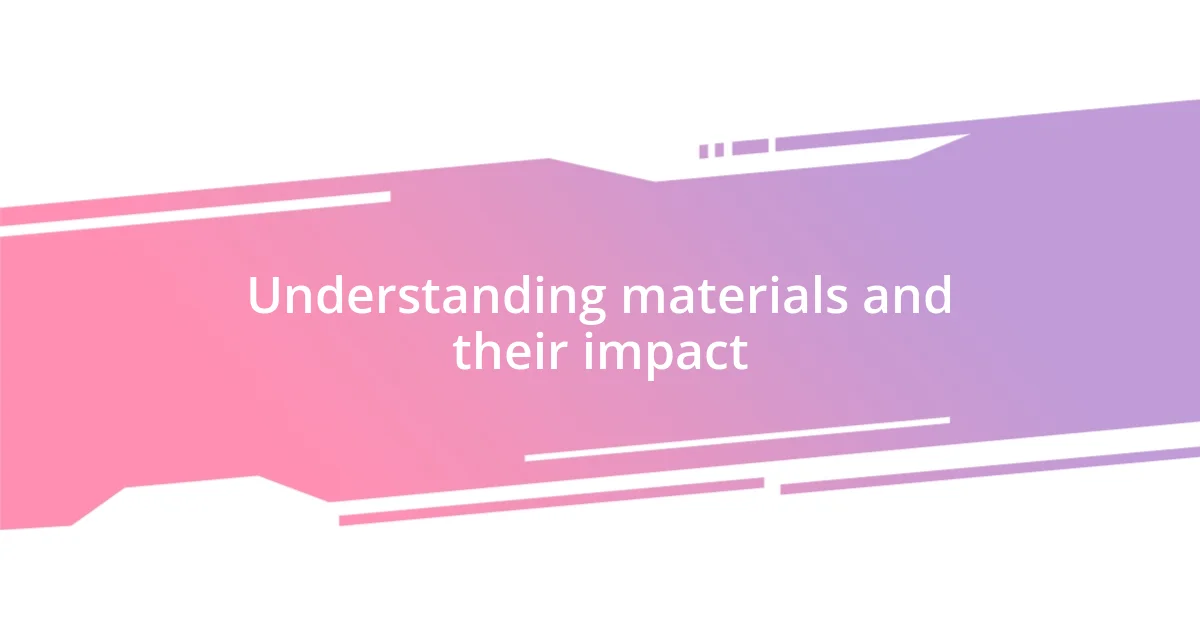Key takeaways:
- Eco-friendly fashion combines style with sustainability, emphasizing quality materials and ethical labor practices.
- Personal experiences with sustainable brands highlight the emotional connection and positive impact of mindful purchasing choices.
- Being informed about materials and shopping responsibly fosters a deeper appreciation for fashion’s environmental impact and encourages sustainable narratives.

Introduction to eco-friendly fashion
Eco-friendly fashion isn’t just a trend; it’s a movement that resonates with our shared responsibility towards the planet. I remember the first time I stumbled upon an eco-friendly brand—I felt a spark of excitement, knowing that my fashion choices could align with my values. It made me wonder, how many have yet to discover that sustainability can be stylish?
When we talk about eco-friendly fashion, we’re really diving into a world where quality meets conscience. Brands are focusing on sustainable materials, ethical labor practices, and minimizing waste. I often find myself reflecting on how the simple act of choosing a dress can ripple out, influencing everything from environmental conservation to labor rights. Doesn’t it feel uplifting to think that our purchasing decisions can make such a significant impact?
Moreover, the journey into eco-friendly fashion has taught me how to look beyond the price tags and trends. I’ve started valuing timeless pieces over fast fashion fads, realizing that sustainability is not just about what we wear but also about how we express ourselves. Have you ever felt that excitement when you find a unique piece that tells a story? That’s the magic of choosing sustainable fashion.

Personal journey with sustainable brands
I’ve always been inspired by the idea of making a positive impact, and my journey with sustainable brands began in a quirky little thrift shop. As I rummaged through the racks, I came across a vintage jacket that spoke to me. It wasn’t just an article of clothing; it was a piece of history that brought along stories of the past. Wearing it now not only makes me feel unique but also connects me to a lineage of eco-conscious consumers. Isn’t it fascinating how fashion can intertwine with our personal narratives?
As I learned more about sustainable brands, I gradually shifted my focus toward companies that prioritize fair trade and transparent sourcing. I remember when I made the leap to invest in a high-quality handbag from a brand known for its ethical practices. At first, I hesitated due to the price, but now it feels like an heirloom—something I’ll cherish for years to come. Who knew that choosing carefully could lead to a brighter future for workers and the environment?
This conscious journey really opened my eyes to the importance of mindfulness in our purchasing decisions. I’ve begun hosting clothing swaps with friends, turning a simple gathering into a celebration of sustainability and creativity. It’s amazing how these moments of sharing and storytelling can foster a community focused on making better choices. Have you experienced a similar transformation in your approach to fashion? I find that it’s not just about what we wear; it’s about the connections we build along the way.
| Brand | Specialization |
|---|---|
| Patagonia | Outdoor apparel and activism |
| Reformation | Trendy fashion with a sustainable twist |
| Everlane | Transparency and ethical production |

How to shop responsibly
When it comes to shopping responsibly, I’ve learned that it’s essential to do a little homework before diving into a purchase. On one occasion, I was drawn to a beautifully made sweater, but I paused to check the materials. I discovered it was made from recycled fibers, which made me feel good about buying it, knowing I was helping reduce waste. This experience sharpened my focus on brands that prioritize sustainability, reminding me that every item has a story worth knowing.
Here are some key tips that I’ve found helpful for responsible shopping:
- Look for certifications like GOTS (Global Organic Textile Standard) or Fair Trade.
- Research the brand’s values and their impact on the environment.
- Choose quality over quantity; invest in items that will last.
- Be mindful of your wardrobe—consider second-hand or upcycled options.
- Ask yourself if you truly need the item, rather than succumbing to fleeting trends.
By following these practices, I feel a sense of empowerment, knowing my choices contribute to a more sustainable future. Each small step I take makes me part of a bigger picture, one where fashion aligns with our responsibility to the earth.

Understanding materials and their impact
Understanding the materials used in fashion has transformed my perspective on what I wear. I remember the first time I learned about organic cotton and its benefits over conventional cotton. The idea that one crop could be grown without harmful pesticides made me rethink my choices. It felt empowering to wear something that not only looked good but also minimized harm to the environment—how can we ignore the impact of our clothing choices?
I’ve also become increasingly aware of synthetic materials and their long-lasting effects on the planet. I once purchased a scarf made from recycled polyester, and the satisfaction I felt knowing that it was repurposed from plastic bottles made a significant difference. Isn’t it incredible how something so mundane can have a positive environmental impact? This experience deepened my appreciation for brands that innovate and utilize materials that reduce waste.
Moreover, as I’ve explored materials, I’ve learned about the importance of transparency regarding sourcing. I vividly recall visiting a local eco-friendly boutique and chatting with the owner about the supply chain of their garments. Hearing her passion for ethically sourced alpaca wool made me realize that materials carry weight—they tell stories of the artisans involved and the ecosystems preserved. What stories do your clothes tell, and how can they become a part of a more sustainable narrative?














